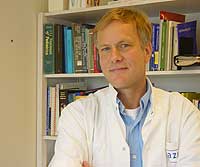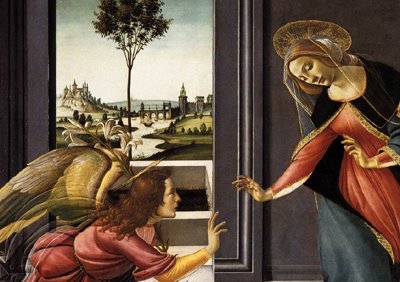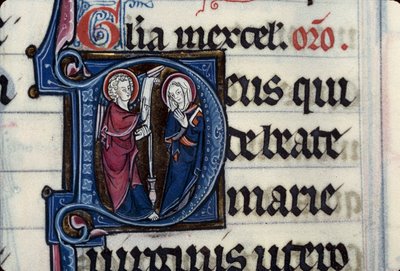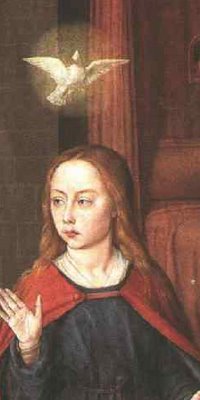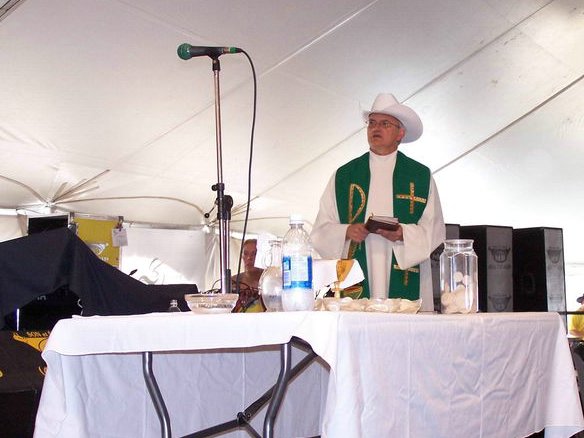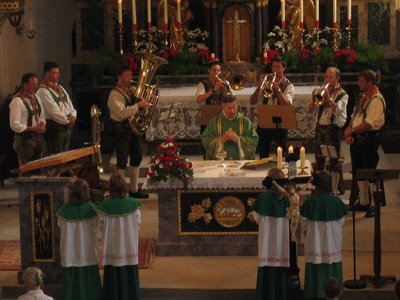I was invited in Naples, Florida, this past week by a group of Una Voce, in order to give some lectures. I spoke about the Liturgy. Here is the first lecture I gave, about the history of liturgical deviations.God bless you and give us the strenght and the courage to persevere in our battle for the restoration of a true Catholic Liturgy in the Church!Father Laurent Demets, FSSP
Introduction – Historical overview
The liturgical question is at the core of the current crisis in the Church. The XX century was the century of the liturgical movement. Paradoxically, it was also the century that brought a great many errors and abuses in liturgical matters. But let us not limit this liturgical problem to the only XX century. The History of the Church shows us that this is not the first liturgical crisis we have struggled through. The Church and the faithful didn’t wait for the XX century to take an interest in liturgy. As a matter of fact, the entire History of the Church, back to the very beginning is marked by liturgical questions. And this is perfectly understandable since liturgy is the expression of the faith of the Church and it involves men, who, by our very nature are imperfect.
With the help of Dom Gueranger, I am going to give you a quick overview of the liturgical errors of the past. I will preface by telling you that I am going to speak only about the Roman liturgy, even though the study and the history of other liturgies is very interested. Unfortunately we don’t have time to consider them. In addition to our time limits, I am not the best one to speak on the topic of the liturgies of other rites, since they are not my 'specialty' like the Roman Rite is.
· Early Church to Middle Ages
In the earliest years of the Church, heretics attacked the liturgy, in order to change the Faith. Paul of Samosata, Arius and then the Donatists changed the liturgy of the Church in order to teach their own doctrine. They composed their own hymns and even their own psalms in order to corrupt the Faith by their false prayers as Dom Gueranger says.
Then we have a period of few centuries during which the Liturgy further develops. It is not my purpose to speak about that today, but let us say that the Roman liturgy and the Gallican liturgy merged together into one with a pre-eminence of the Roman liturgy. The unification of the Empire under the reign of Charlemagne helped a lot. The Roman liturgy finally became predominant throughout all Europe.
The XIV and XV centuries knew a certain adulteration, especially in the area of chant. Novelties in the way of singing appeared and Pope John XXII had to intervene with his bull “Docta Sanctorum” in 1322.
· Renaissance
Then came the Humanist period, which provoked some unfortunate attempts at reform. The idea was that the ecclesiastical Latin was too rudimentary. The pontifical court was then full of poets and writers for whom the goal was to reform the Latin and they started to compose again all the hymns for the liturgical year. Pope Leo X himself ordered the composition of a new hymnal. The hymnal of Ferreri – Bishop Zacharie Ferreri was the artisan of this hymnal – was finally approved by a Brief of Pope Clement VII in 1525. According to this Brief, every cleric could choose the prayers he wanted for the Divine Office. Ten years later a new breviary was also approved. It is known as the Breviary of Quignonez, from the name of its composer Francois Cardinal Quignonez. Cardinal Quignonez had the reputation of being a man of great piety and a sincere love for the liturgy. The intention was good: it was to renew the devotion of the clerics. Nevertheless the effects were disastrous, since they were made at the expense of Tradition.
If we take stock of this reform made under the authority of these three Popes – Leo X, Clement VII and Paul III – we can only say that is was a disaster – the word is from Dom Gueranger for whom Romanita cannot be suspected. It must be acknowledged that the University of Paris has censored this Breviary promulgated by the highest authority of the Church.
The commentary of Dom Gueranger is pretty interesting. The character of the influence The Holy See exercised on the publication of this Breviary of Quignonez contradicts all that we can see in all the centuries before or after. (That was written in the XIX century!) Rome seems to desire that we use this form of Office but on other hand seems to timid to make it law. We feel as though we are in a state of transition that will last until a Pontiff – Saint Pius V – chosen by God to succeed Leo, Gelasius or Gregory comes and reforms in a saintly way the Divine worship as the Church speaks.
This reform was about the Breviary and didn’t concern the Holy Mass. But the Divine office is still a part of the Liturgy of the Church and what happened in the XVI century can help us deal with the actual liturgical wreck. Dom Gueranger gives us some considerations we can apply, mutatis mutandis, to the actual situation.
- In order first to last, the reform of the liturgy must be done by pious persons and not by erudite persons.
- In a reform of the liturgy, we must beware of novelties.
- Shortening the liturgy is not reforming it!
· The Reformation
The Protestant heresy had much impact on the Liturgy. The idea of Luther was to free man from the servitude of thought regarding the teaching power of the Church and from the servitude of the body regarding the liturgical power.
Dom Gueranger gives the principles of what he calls the “ anti-liturgical heresy.”
- Hatred of the Tradition in the expressions of the Divine worship.
- Replacing the ecclesiastical style words with readings from the Bible. The purpose is to delete what is born from Tradition and to promote the Protestant doctrine with a judicious choice of texts from the Bible. All heresies have their origin in Scriptures, but not on Scripture as a whole, only on carefully chosen passages which support their particular ideas. By the way, the meaning of the word “heresy” in Greek is “choice”.
- The fabrication and introduction into the liturgy of different words in order to spread their doctrine.
- Removing all the words that express the mysteries of the Faith. For examples, they prefer to speak about a table rather than an altar, or about the Lord’s Supper rather than the sacrifice.
- The use of the vernacular for the liturgy. Dom Gueranger says about that: The hatred of the Latin language is in the heart of all the enemies of Rome. They consider it as the good of the Catholics in the whole world, the arsenal of orthodoxy against the subtleties of the sectarian spirit.
- The hatred of the papacy, which is the foundation stone of the entire edifice that is the Church.
- The destruction of priesthood.
· The answer of the Church - a true Catholic Reform: The Council of Trent – Saint Pius V
At the 25th Session of the Council of Trent, it had been decided to entrust the Pope with the reform of the Liturgy. Pius IV began a reform of the breviary but he died and his successor, Pius V continued. The breviary of Quignonez was abolished and replaced by the Roman Breviary.
Then the Roman Missal was restored in 1570. All the dioceses had to embrace this missal except those who had a missal more than 200 years old. Almost all the dioceses of Europe accepted the Missal and the Breviary of Saint Pius V except Milan in Italy and Lyon in France, which had their own antique liturgies.
Then the occidental Church knew many decades of liturgical unity. The reform continued with the publication of the Martyrology, the Pontificale and the Rituale.
· The liturgical deviation in France ( XVII – XVIII )
It sometimes happens that the eldest daughter of the Church is also rebellious daughter. Two important trends would have a great impact on the Church in France until the XX century, these are Jansenism and Gallicanism. These trends had consequences in liturgical matter.
In 1660 Joseph de Voisin, Doctor of the University of Sorbonne published a translation in French of the Roman Missal. The Assembly of the clergy of France immediately condemned this translation. Pope Alexander VII approved this condemnation. In his Brief, He condemned those who have the impudence to translate the Roman Missal, written in the Latin language, into the French language. For the Pope this is a deterioration of the most sacred rites, which debases the majesty that the Latin language gives to them. It is a mark of the hatred of mystery. Finally the Pope prohibited the printing and the reading of the Missal in French under a sentence of excommunication.
That seems to be excessive, especially today since we have now many translations of the Missal in vernacular languages. In the XIX century, when Dom Gueranger wrote his book, there were already many translations available. And Dom Gueranger explains that it is now possible but a translation has to be accompanied by some commentary approved by the Church. Giving the translated text to the faithful without any explanations of the mysteries of the Faith would open the door to numerous and faulty personal explanations.
Then the liturgical attacks came. First was the Rituale of Alet in 1667 whose Jansenist influence was great. The Breviary of Vienne in 1678 and the Breviary of Harlay in 1680 brought more novelties. This Breviary marked the reversal of the work of Charlemagne and the Popes. This Breviary, for the use of the diocese of Paris, created a new Office which had nothing to do with the Roman Breviary. After the Breviary, Harlay, who was archbishop of Paris, published his own missal. The principle was to use only texts from the Bible that was the idea Luther had. Nevertheless, the Missal of the diocese of Paris, in spite of unfortunate changes, was still the Roman Missal.
The Abbey of Cluny went further by exchanging its old breviary for a new one. Once again the idea was to use only the words from the Scriptures. Yet some new compositions by writers of this century appeared anyway, contradicting the purpose the innovators of this breviary had claimed to be their reasoning for the changes. They even changed the liturgical calendar. The admitted goal was to diminish the cult of the Saints, especially the cult of Our Lady.
You will not be surprised to learn that among the members of the committees for the redaction of the breviary of Paris and the breviary of Cluny, were some notorious Jansenists. They attacked the true Faith through the Liturgy.
The attacks were more virulent in the XVIII century. The recitation of the Canon of the Mass in a loud voice appeared as a trend. As Dom Gueranger points out, this was: the seeds of a revolution. Indeed, if we read the Canon in a loud voice, people would ask to read it in the vernacular language. And then, people could become judges in the teaching of the Faith, which is exactly what we see today in so many places. And once again, that had already been the strategy of Luther and Calvin.
The Council of Trent had already condemned this audacity during the 22nd session. Listen to the 9th canon: CANON IX.--If anyone says, that the rite of the Roman Church, according to which a part of the canon and the words of consecration are pronounced in a low tone, is to be condemned; or, that the mass ought to be celebrated in the vulgar tongue only; let him be anathema.
But this didn’t prevent the abuses of the innovators. Thus a new Missal was printed for the diocese of Meaux – the diocese of the famous Bossuet, just few years earlier! Regardless of the integrity of the Liturgy, they introduced novelties in the rubric of the Missal, such some responses preceded by the a big letter R in red to indicate that the congregation has to make the responses just after the words of the consecration and the words of the communion. Thanks be to God, the Bishop of Meaux, who was the successor of Bossuet, did not approve this missal and prohibited it under the sentence of suspension.
But in spite of the orthodoxy of many good bishops and priests – as Father Le Brun, for example, who wrote a very good book about the Holy Sacrifice of the Mass – the novelties increased throughout the entire country.
The Missal of Troye was published in 1736. Its rubrics dictates that the Canon has not to be said “ submissa voce ” – in a low voice – but “ submissiora voce ” – in a lower voice! The Troyen Missal also dictates that a priest who says a solemn Mass does not have to say the prayers and readings sung by the choir or said by other ministers. The altar crucifix and the candles are no longer mandatory. The second Confiteor before the communion was removed. Many texts born from Tradition throughout the centuries were replaced by texts from the Scriptures. A good Bishop, Jean-Joseph Languet de Gergy, archbishop of Sens denounced this Missal for being full of Calvinist conceptions.
The rabid trend of secularization and naturalization of the Liturgy did not abate. The symbolism and mysticism of the rites was attacked. In the name of reason – this was the “Century of Lights” – when it seemed necessary to find an explanation for all, even for the mysteries of the Faith. In accordance with this, they claimed that people needed to understand all the ceremonies of the Liturgy. Hence a simplification of the rites.
The parish of Asnières, a town near Paris, embodied perfectly the goals of the innovators. The pastor at Asnières was Father Jacques Jubé, a zealous Jansenist. Now, let me describe how the liturgy of this parish was – and I remind you this liturgy I am about to describe was a liturgy in the XVIII century.
There was only one altar in the church, called “Sunday altar” because Mass took place only on Sunday and feast days. When there was no Mass, this altar was totally stripped, as every altar has to be on Good Friday. For Mass, they just put one altar cloth and nothing else: no crucifix, no candle. The only crucifix in the sanctuary was the crucifix of procession that preceded the priest as he ascended the altar. After the beginning prayers of the Mass, he went to sit on a seat on the epistle side from where he started the Gloria and the Credo without reciting them in full, nor were the pieces sung by the choir. During the offertory, there was a procession and bread and wine were offered to the priest. Dom Gueranger says this custom was not reprehensible in itself since it was usual in France in many dioceses at this time, and came from an old tradition. The problem was that in the church of Father Jubé, they added fruits and vegetables which they placed on the altar along with the bread and wine to be consecrated. Then the chalice was brought to the altar without a veil. The priest and the deacon said the prayers of the offering of the chalice in a loud voice to signify that they offered it in the name of the congregation. The Canon was in a loud voice also. And there were no specific prayers before communion.
Are you not familiar with this liturgy? I would say, yes, except for one thing. It was still all in Latin. But as you see, our innovators of today have not come up with anything new. They have simply copied the liturgy of the Jansenists from the XVIII century.
We now look at the Missal of Vintimille, published by the Archbishop of Paris, Charles-Gaspard de Ventimille in 1738. In addition to all previous changes made to the Roman Missal, there was now a complete modification of the parts of the Proper in this new Missal of Ventimille. The intention of Archbishop Vintimille was to arouse piety, to make the chant easier to sing and to renew the Faith, Hope and Charity of the people. But as Dom Gueranger continuous to point out, this was also the goal of Popes Saint Gregory and Saint Pius V and there was no need to change what the Church had established. In order to infuse a new richness in the Liturgy, the doctors of the Sorbonne composed new Prefaces, instead of using the traditional Prefaces available in the old Sacramentaries. At the height of these innovations one of the authors was expulsed from the University of Sorbonne as a heretic. Once again, the consequences were disastrous. By the second half of the XVIII century, three quarters of the French dioceses have abandoned the Roman Liturgy. The French Revolution with its Civil Constitution of the Clergy, which created a schismatic Church, would soon foment further confusion.
· The Synod of Pistoia (Italy 1786)
Scipion de Ricci, Bishop of Pistoia, wanted to introduce to Italy the ideas of his friends from France. With the approbation of the Grand Duke of Tuscany, he convoked a “Diocesan Council” as he called it. Here are some of the reforms they tried to impose:
- They wanted to rid the churches of much of their precious and exquisite decorations.
- Reforming religious orders. They shouldn’t have churches open to the congregations. Their Divine Office would be diminished and they would be permitted to have only one or two Masses a day in their churches. The other priests would have to concelebrate.
- Suppressing processions in honor of Our Lady or the Saints.
- Removing pictures of the Sacred heart and any other pictures that express a “false dogma”
- Only one altar in every churches, which should be without relics or flowers
- Use of the vernacular language in a loud voice
- There would be exposition of the Most Holy Sacrament only once a year for the feast of Corpus Christi. A blessing with the ciborium could be given every Sunday.
- They advised against the Station of the Cross
Fortunately, this Synod was condemned by Pope Pius VI with his famous Bull Auctorem Fidei in 1794.
· First efforts of restoration in the XIX
The coming of Pope Pius VII to France for the coronation of Napoleon proved that the love for the true liturgy was not dead in France. The Pope remained four months in the country and everywhere he went, the churches were full and thousands of faithful tried to receive communion from his hand. The spectacle of these crowds singing the Credo in unison with the Pope was a sign of the beginning of the restoration of the Roman Liturgy in France.
This restoration would be done time after time in the dioceses of the country. The restoration of the Benedictine Order by Dom Gueranger in Solesmes would have an important role.
*
* *
Let us now draw some conclusions from this historical overview. First I would say that the Novus Ordo is not, as its name says, new at all. It is rather the outcome – or should I say the triumph? – of the assault by what Dom Gueranger calls “anti liturgical sect.” It appears that Bugnini is not an innovator, but rather a copier of the Jansenists of the XVIII century. But there is a major difference, and herein lies the problem.
In the past all the so-called reforms were made against the will of the Pope, or at least without his approbation. We can wonder about the silence of the Vatican regarding the liturgical experimentation in France in the XVII and XVIII centuries. But a silence from the highest authority doesn’t necessarily mean approbation. In fact, Rome had already spoken at Trent and then through the pen of Pius V. Rome spoke again through Pius VI who condemned the liturgical abuses proposed by the Synod of Pistoia.
But today, the Missal of Bugnini has been requested, approved and promulgated by the Pope, so that we don’t call it the Missal of Bugnini, but the Missal of Paul VI. The Vatican itself has tried to make everybody believe that this Missal is now the only missal for the Roman Church and that the Missal of Saint Pius V has been abolished. Yet, this is a lie.
Thanks be to God, after 30 years of resistance, the Vatican has had to acknowledge that this old and venerable Missal is still in effect, and further, that every priest of the Roman Rite may freely celebrate Mass according to this Missal of Saint Pius V without any specific permission. But this right has yet to be recognized everywhere. The Tridentine Mass still has many enemies everywhere within the Church.
In fact there is a precedent in History with the Hymnal of Ferreri and the Breviary of Quignonez promulgated with the approbation of the Pope. And for this particular precedent I say, thanks be to God, because this precedent shows us that even with the authority of the Pope, a liturgical reform can be wrong. A good reform, indeed, is not a creation of something new, but a restoration of the Tradition when it happens to have been damaged in some way. And that is what distinguishes the true reformer Popes from the others. On one hand, we find some Popes as Saint Gregory the Great, Saint Gregory VII, Saint Pius V and Saint Pius X. On the other hand, we have Leo X, Clement VII, Paul III and Paul VI.
My intention is not to set these Popes in opposition or necessarily to say that some Popes are better than others, although it is a fact that the great reformers of the Liturgy have been canonized. Maybe it is a strong indication that a good reform can be done only holy persons rather than erudite persons as we have already said. But what is true – and this will be my conclusion for today – is that a good reform brings unity and harmony. We judge the tree by its fruits.

